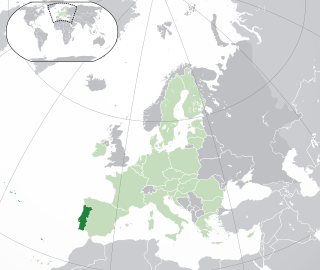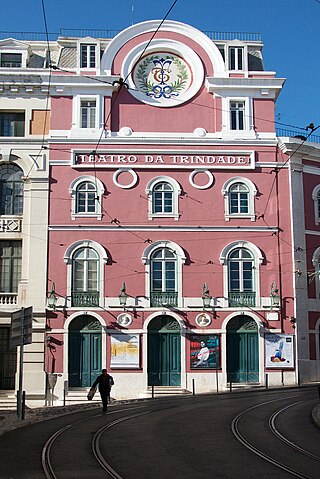
The Santa Justa Lift, also called Carmo Lift, is an elevator, or lift, in the civil parish of Santa Maria Maior, in the historic center of Lisbon, Portugal. Situated at the end of Rua de Santa Justa, it connects the lower streets of the Baixa with the higher Largo do Carmo.

Polytechnic of Porto - School of Engineering (ISEP) is a public polytechnic higher learning and research engineering institute, located in the city of Porto, Portugal. ISEP is divided into eight departments, with an emphasis on applied science and technology.

Altice Portugal S.A. is the largest telecommunications service provider in Portugal. Since 2 June 2015 the company has been a wholly owned subsidiary of Altice, a multinational cable and telecommunications company with a presence in France, Israel, Belgium, Luxembourg, Portugal, French West Indies/Indian Ocean Area, the Dominican Republic, and Switzerland. The assets in Portugal were sold to Altice in 2015 per request of Oi SA to reduce debt. The African assets were mostly sold for the same reason. Portugal Telecom, SGPS SA was split in separate companies: PT Portugal and Pharol, which owns a 27.5% stake in Oi.
A postal, telegraph, and telephone service is a government agency responsible for postal mail, telegraph, and telephone services. Such monopolies existed in many countries, though not in North America, Japan or Spain. Many PTTs have been partially or completely privatised in recent years, though a few, such as Posta ve Telgraf Teşkilatı of Turkey, Myanma Posts and Telecommunications of Myanmar and Tusass of Greenland, continue to remain wholly government-owned. In many of said privatisations, the privatised corporation was completely renamed, such as KPN in the Netherlands, Orange S.A. in France, BT Group in the United Kingdom, Eir in the Republic of Ireland, Swisscom in Switzerland, Telstra in Australia, Spark in New Zealand, Proximus Group in Belgium, A1 Telekom Austria Group in Austria, TDC Group in Denmark, Telia Company in Sweden and Finland, Telenor in Norway, Chunghwa Telecom in Taiwan and Singtel in Singapore; whereas in others, the name of the privatised corporation has been only slightly modified, such as Telkom Indonesia in Indonesia, Telekom Malaysia in Malaysia, Deutsche Telekom in Germany, Kosovo Telecom in Kosovo, KT in South Korea, Post Luxembourg in Luxembourg and Síminn in Iceland.
Instituto Industrial e Comercial de Lisboa was a former Portuguese school of vocational education founded in 1852 as Instituto Industrial de Lisboa, by Minister Fontes Pereira de Melo decree of 30 December. Its aim was the creation of a technical school of vocational education, whose purpose was to facilitate the ongoing industrialization process set up by Pereira de Melo. The education of a large number of skilled industrial technicians in several areas, was one among many innovative reforms Pereira de Melo idealized as Minister. This qualified workers were suited to deal with the new needs in industry.

CTT – Correios de Portugal, S.A. is a Portuguese company that operates as both the national postal service of Portugal and a commercial group with subsidiaries operating in banking, e-commerce, and other postal services. It was founded in 1520 by King Manuel I of Portugal, during the Portuguese Renaissance, and CTT is the oldest company still in operation in Portugal to this day.

CP — Comboios de Portugal, EPE is a state-owned company which operates passenger trains in Portugal. Prior to June 2009, CP stood for Caminhos de Ferro Portugueses although the company has been using its current designation as a brand name since 2004.

Euronext Lisbon is a stock exchange in Lisbon, Portugal. It is part of Euronext pan-European exchange. The most famous index is PSI-20.
The Monastery of the Mónicas, located in São Vicente, Lisbon, was a Portuguese nunnery dedicated to the mother of Augustine of Hippo, Saint Monica. It later became a prison.

Olivais is a freguesia and typical quarter of Lisbon, the capital city of Portugal. Located in eastern Lisbon, Olivais is west of Parque das Nações, north of Marvila and Alvalade, and east of Lumiar and Santa Clara. The population in 2021 was 32,179.

MEO is a mobile and fixed telecommunications service and brand from Altice Portugal, managed by MEO - Serviços de Comunicações e Multimédia. The service was piloted in Lisbon in 2007 and was later extended to Porto and Castelo Branco.

Portugal changed to a closed telephone numbering plan on 31 October 1999; previously, the trunk prefix was '0', but this was dropped.

The Santa Apolónia Station is the oldest railway terminus in Portugal. It is situated in the civil parish of São Vicente, in the central part of the municipality of Lisbon, on the northern margin of the Tagus River in the historical district of Alfama.

The Coliseu dos Recreios is a multi-purpose auditorium located in Lisbon, Portugal.
Dr. Manuel Alcindo Antunes Frasquilho was a Portuguese transportation executive and politician. He served, at different times, as President of the Port of Lisbon Administration and of the Lisbon Metro, for which he was known for expanding the metro and reducing its costs significantly, gaining him the epithet "turbogestor" ("turbo-executor"). He also served as the chairman of the board of Comboios de Portugal, Portugal's state-owned rail company.

Santa Apolónia station is the southern terminus on the Blue Line of the Lisbon Metro.

The Project for the Royal Palace in Campo de Ourique was an ambitious 18th century proposal for a monumental royal palace to be built in the Campo de Ourique neighborhood of Lisbon. Portuguese architect Dionizio de S. Dionizio planned the palace for King Joseph I of Portugal as part of the reconstruction efforts following the destruction of the 1755 Lisbon Earthquake.

The Teatro da Trindade is a theatre in the Chiado neighbourhood of Lisbon, Portugal, built in the 19th century. It is one of the oldest theatres in Lisbon still in operation.

William Godfrey Thomas Pope was a British citizen, who distinguished himself as an engineer and businessman in Portugal as General Manager of the Anglo-Portuguese Telephone Company.

The Portuguese Railway Company was the main railway operator in Portugal. Founded on 11 May 1860 by the Spanish businessman José de Salamanca y Mayol under the name Companhia Real dos Caminhos de Ferro Portugueses, it changed its name after the 5 October 1910 Revolution. In the first half of the 20th century, it underwent a process of expansion, assimilating several private railway companies and the railways that had been under the management of the Portuguese government. However, the effects of the Second World War, and the advance of road and air transport its economic situation deteriorated to such an extent that, after the Carnation revolution, the company had to be nationalised and transformed into a new institution, called Caminhos de Ferro Portugueses [Portuguese Railways].
















